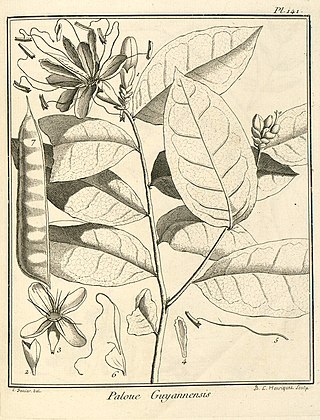
Bauhinia is a large genus of flowering plants in the subfamily Cercidoideae and tribe Bauhinieae, in the large flowering plant family Fabaceae, with a pantropical distribution. The genus was named after the Bauhin brothers Gaspard and Johann, Swiss-French botanists.

Glycydendron is a genus of plants, under the family Euphorbiaceae first described as a genus in 1922. It is native to South America.
- Glycydendron amazonicumDucke - French Guinea, Suriname, Guyana, Ecuador, Peru, Bolivia, northwestern Brazil, possibly Colombia
- Glycydendron espiritosantenseKuhlm, - State of Espirito Santo in Brazil

Parkia is a genus of flowering plants in the family Fabaceae. It belongs to the mimosoid clade of the subfamily Caesalpinioideae. Several species are known as African locust bean.

Dimorphandra is a genus of legume in the family Fabaceae, subfamily Caesalpinioideae. It includes 26 species native to northern South America, ranging from Colombia and Venezuela to Bolivia, Paraguay, and southeastern Brazil.

Macrolobium is a legume genus in the subfamily Detarioideae. It is a tropical genus with about 80 species. Half occur in Brazil, where they are common in the floodplains of the Amazonian Basin. Members of the genus are used as ornamentals and for their wood.

Macrosamanea is a genus of flowering plant in the legume family, Fabaceae. It includes 11 species of trees and shrubs native to northern South America. The genus is most diverse and numerous in the Amazon Basin, extending into the Orinoco basin and the Guianas. Typical habitat is tropical rain forest, mostly riparian and seasonally-flooded. Two species are native to seasonally-inundated wooded grassland (savanna) on sandy soils. The genus belongs to the mimosoid clade of the subfamily Caesalpinioideae.

Stryphnodendron is a genus of flowering plant in the legume family, Fabaceae. It includes 28 species of trees and suffrutices native to the tropical Americas, ranging from Nicaragua to Bolivia, Paraguay, and southern Brazil. Typical habitats include tropical rain forest and riparian forest, seasonally dry forest, cerrado, and caatinga. It belongs to the mimosoid clade of the subfamily Caesalpinioideae.

Swartzia is a genus of flowering plants in the family Fabaceae. It was named in honor of Swedish botanist Olof Swartz and contains about 200 species. Swartzia is restricted in its geographical distribution to the New World Tropics, where it occurs primarily in lowland rainforests, but also in savannas, pre-montane forests, and tropical dry forests. While it can be found throughout the wet lowlands from Mexico and the Caribbean islands to southern Brazil and Bolivia, Swartzia is most abundant and species-rich in Amazonia, where 10–20 species may co-occur at a single site. The species of Swartzia are mostly trees, ranging from small understory treelets to large canopy emergents. Some species, especially in savannas, are mult-stemmed shrubs.

Tachigali is a flowering plant genus in the legume family (Fabaceae). It contains about 75 species.

Quiina is a genus of plant in family Ochnaceae. It contains the following species :

Aldina is a genus of trees in the Fabaceae native to the Guiana Shield and northern Amazonia. It is found in lowland humid forests.

Campsiandra is a genus of flowering plants in the family Fabaceae. It includes 22 species native to northern South America. The genus belongs to the subfamily Caesalpinioideae.

Eperua is a genus of flowering plants in the legume family, Fabaceae. It belongs to subfamily Detarioideae. It includes 16 species native to northern South America, in Colombia, Venezuela, the Guianas, and northern Brazil. They live in the jungles, often along rivers or streams. The leaves are compound pinnate, with smooth margins, and the fruits are long pods. The wood of E. falcata is called wallaba and is often used in construction.

Dicymbe is a genus of 20 species of canopy trees in the family Fabaceae, within subfamily Detarioideae. It is found throughout the Guyana Shield region and parts of W Amazonia. Certain species within the genus are strongly associated with ectomycorrhizal fungi.

Paloue is a genus of flowering plants in the family Fabaceae. It belongs to the subfamily Detarioideae. The genera was first created with the description of Paloue guianensis by Aublet in 1775.
Clathrotropis is a genus of flowering plants in the family Fabaceae. It includes 7 species native to northern South America, ranging from Peru to Colombia, Venezuela, the Guianas, and northern Brazil. The genus belongs to subfamily Faboideae.

Macropsychanthus is a genus of flowering plants in the legume family, Fabaceae. It belongs to the tribe Diocleae, subfamily Faboideae. The genus has 47 species with a pantropical distribution, ranging through the tropical Americas from southern Mexico to northeastern Argentina, west and central Africa, Madagascar, Indochina, Malesia, Papuasia, and Queensland.
Roucheria is a genus of flowering plants belonging to the family Linaceae.

Pleurisanthes is a genus of flowering plants belonging to the family Icacinaceae.
Zanthoxyloideae is a subfamily of the family Rutaceae.

















